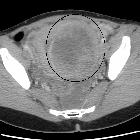Embolisation Vena ovarica

Pelvic
congestion syndrome therapiert mit Coiling der V. ovarica. Mit abgebildet ist eine Targon-Osteosynthese bei Schenkelhalsfraktur rechts.
Ovarian vein embolization is an interventional technique primarily used towards the treatment of varicosities.
Indications
The main indications are:
- as part of management of pelvic congestion syndrome
- to treat pelvic varicosities diagnosed by imaging
- to treat labial and/or perineal varicosities
Contraindications
- allergic reaction to contrast media
- coagulopathy
- renal insufficiency
Preprocedural assessment
- clinical history and examination of pelvis and perineum by a gynecologist
- pelvic ultrasound/CT/MRI
- diagnostic laparoscopy in selected cases
- patient counseling: etiology of the chronic pelvic pain and its treatment options
Patient preparation
- informed consent
- IV access
- clear fluids per oral for 4-6 hours prior to procedure
- sedation with Midazolam 2 mg and fentanyl 100 microgram IV
Procedure
- venous access can be either through a internal jugular route or a femoral venous route
- after introducing a 5-7 F vascular sheath in the selected vein, an appropriate 5 F catheter is advanced into the left renal vein (multipurpose catheter through IJV access; Cobra catheter through femoral vein access)
- renal venography is performed by a forceful injection while patient is performing Valsalva maneuver
Siehe auch:
und weiter:

 Assoziationen und Differentialdiagnosen zu Embolisation Vena ovarica:
Assoziationen und Differentialdiagnosen zu Embolisation Vena ovarica:


